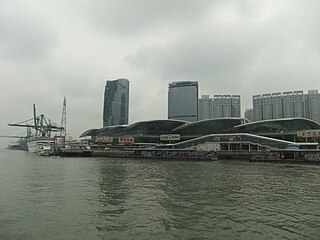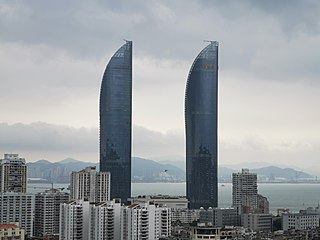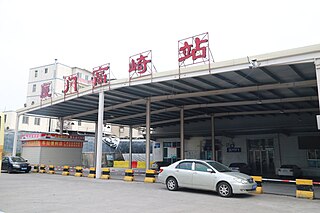
Xiamen, also known as Amoy, is a sub-provincial city in southeastern Fujian, People's Republic of China, beside the Taiwan Strait. It is divided into six districts: Huli, Siming, Jimei, Tong'an, Haicang, and Xiang'an. All together, these cover an area of 1,700.61 square kilometers (656.61 sq mi) with a population of 5,163,970 as of 2020 and estimated at 5.28 million as of 31 December 2021. The urbanized area of the city has spread from its original island to include most parts of all six of its districts, and with 4 Zhangzhou districts, form a built-up area of 7,284,148 inhabitants. This area also connects with Quanzhou in the north, making up a metropolis of nearly ten million people. The Kinmen Islands (Quemoy) administered by the Republic of China (Taiwan) which lie less than 6 kilometers (4 mi) away separated by Xiamen Bay.

Xiang'an is one of the districts of Xiamen, People's Republic of China. It is located on the mainland, and is Xiamen's easternmost district.

Xiamen Gaoqi International Airport is the airport serving the city of Xiamen in Fujian Province, China. It is the main base of XiamenAir and TAECO, an aircraft maintenance provider. The airport is located on the north side of Xiamen Island. Construction of a new terminal started in October 2011 and was completed in 2014.

Zhanqiao pier is located at the southern shore of Qingdao off Zhongshan Road. This now 440-meter-long (1,443.6 ft) pier, constructed in 1891, was Qingdao's first wharf. The octagonal Hunian pavilion was constructed in 1930, and features as the logo of Tsingtao Brewery.

The Port of Xiamen is an important deep water port located on Xiamen Island, the adjacent mainland coast, and along the estuary of the Jiulongjiang River in southern Fujian, China. It is one of the trunk line ports in the Asia-Pacific region. It is ranked the 8th-largest container port in China and ranks 17th in the world. It is the 4th port in China with the capacity to handle 6th-generation large container vessels. In 2013, Xiamen handled 191 million tons of cargo, including 8.08 million TEUs of containers. On 31 August 2010, Xiamen Port incorporated the neighboring port of Zhangzhou to form the largest port of China's Southeast. This was a relatively uncommon case of ports merging across jurisdictions.

Huli (help·info) is one of the administrative districts of the city of Xiamen, People's Republic of China.

Jimei (help·info) is one of six districts of Xiamen, People's Republic of China. Founded in 1992, with an area of 270 square kilometres (100 sq mi), in 2003 it gained some territory in a reorganisation of district governments.

Xiamen's Bus Rapid Transit (BRT) is a bus rapid transit system in Xiamen, Amoy, China. It was formally put into operation on August 31, 2008 and is considered China's first elevated BRT network. Eventually the system will be rebuilt into an elevated metro network and be integrated with the Xiamen Metro.

Xiamen North railway station is a railway station located in Houxi Town, Jimei District, Xiamen City, Fujian Province, China, on the Fuzhou-Xiamen railway and Xiamen-Shenzhen railway which operated by Nanchang Railway Bureau, China Railway Corporation. It was built to allow train lines that pass through Xiamen to continue to the south west rather than ending in Xiamen at Xiamen railway station. Due to this advantage it is now bigger than Xiamen railway station.

The Fuzhou–Xiamen railway or Fuxia railway is a dual-track, electrified, high-speed rail line in eastern China. The line is named after its two terminal cities Fuzhou and Xiamen, both coastal cities in Fujian. The line has a total length of 274.9 kilometres and forms part of China's Hangzhou–Fuzhou–Shenzhen passenger-dedicated railway. Construction began in 2005, and the line entered into operation on April 26, 2010.

Xiamen Metro, officially branded as AMTR, is a rapid transit system serving Xiamen, Fujian, China. Line 1 began operation on 31 December 2017. Line 2 began operation on 25 December 2019. Line 3 began operation on 25 June 2021.

Gaoji Causeway is a 2,212-meter-long causeway in Xiamen, Fujian, China. It links Gaoqi in downtown Xiamen Island across the Xiamen Bay to Jimei District on the mainland. It used to serve as a road and rail link, as well as water piping into Xiamen Island. In order to improve the water quality around Xiamen Island, part of the causeway was blasted off and removed, replaced by bridge, and it would serve only as road link. Completed in 1955, along with Wuhan Yangtze River Bridge, the causeway is considered one of the major construction projects in the early years of the People's Republic of China. It remained Xiamen Island's sole link with the mainland until 1991. The Gaoji Causeway has a museum devoted to its construction and history founded in 2013.
The Zhongzhou Park is a park in Lanxi, Zhejiang, China. It is located on an island in the Lanjiang River.

Xiamen Xiang'an International Airport is an airport being built to serve the city of Xiamen in Fujian Province, China. Once completed, it will replace the existing Xiamen Gaoqi International Airport as the city's main airport. The airport is located on the Dadeng Island in Xiang'an District, facing Nan'an, Quanzhou to the north. It is 15 km (9.3 mi) from Kinmen in the Republic of China, 25 km (16 mi) from central Xiamen, 44 km (27 mi) from downtown Quanzhou, and 72 km (45 mi) from Zhangzhou.
The Coastal corridor is a high-speed rail corridor running along the eastern coast of China, stretching from Dalian in the north to Fangchenggang in the south and passing through the cities of Qinhuangdao, Tianjin, Dongying, Weifang, Qingdao, Lianyungang, Yancheng, Nantong, Shanghai, Ningbo. Fuzhou, Xiamen, Shenzhen, and Zhanjiang. The Weifang–Qingdao stretch splits into two, one directly connecting Weifang to Qingdao, the other connecting Weifang to Qingdao through Yantai. Announced in 2016 as part of the national "eight vertical and eight horizontal" high-speed railway network as an expanded Hangzhou–Fuzhou–Shenzhen passenger railway from the "four vertical and four horizontal" plan. The line will comprise a mixture of high-speed railway lines, upgraded conventional rail lines and intercity railways.

Island Ring Road or Huandao Road is a city thoroughfare making a loop around Xiamen Island, Xiamen, Fujian, China. It passes through the districts of Siming District and Huli District. It is 43 kilometers long, and its number is County Route 401.

Jimei Bridge is a highway bridge on the north side of Xiamen, Fujian, China. Constructed December 2006, opened to traffic July 1, 2008. It is Xiamen Island's third bridge connecting to the mainland. As the bridge's head is in proximity to Xiamen Gaoqi International Airport, a tunnel has been built under the runway to prevent the airport operations from being affected. The total length of the bridge is 10.057 kilometers: the bridge proper is 3.82 kilometers, and the tunnel is 1.4 kilometers. The bridge connects to five interchanges, and there are two toll stations. The estimated total investment of the project is 2.955 billion yuan.

Shimao Cross-Strait Plaza, also known as Shimao Straits Tower, Shimao MO Sky Mansion, and Xiamen Shimao Straits Mansion, is a skyscraper complex in Xiagang, Siming District, Xiamen, People's Republic of China. The project was completed in 2015, and the architect was Gensler.

Xiamen Gaoqi railway station is a freight railway station in Huli District, Xiamen, Fujian, China.


















